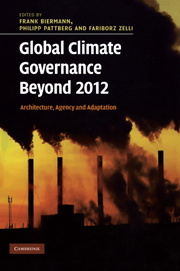Book contents
- Frontmatter
- Contents
- List of contributors
- Preface
- List of abbreviations
- 1 Global climate governance beyond 2012
- Part I Architecture
- Part II Agency
- 9 Agency in global climate governance
- 10 The role and relevance of networked climate governance
- 11 Carbon market governance beyond the public–private divide
- 12 A staged sectoral approach for climate mitigation
- 13 Technological change and the role of non-state actors
- Part III Adaptation
- Index
- References
12 - A staged sectoral approach for climate mitigation
Published online by Cambridge University Press: 05 July 2014
- Frontmatter
- Contents
- List of contributors
- Preface
- List of abbreviations
- 1 Global climate governance beyond 2012
- Part I Architecture
- Part II Agency
- 9 Agency in global climate governance
- 10 The role and relevance of networked climate governance
- 11 Carbon market governance beyond the public–private divide
- 12 A staged sectoral approach for climate mitigation
- 13 Technological change and the role of non-state actors
- Part III Adaptation
- Index
- References
Summary
Introduction
A major question in negotiations on international climate mitigation is how to allocate future greenhouse gas emission reduction targets among countries. For this reason, many proposals for allocating emission reductions among countries have been developed (Aldy et al. 2003; Bodansky 2004; Kameyama 2004; Torvanger and Godal 2004; Blok et al. 2005; Gupta et al. 2007; Hof et al., this volume, Chapter 4). Most of these proposals are based on one or more equity principles. According to these principles, emission reductions are allocated on the basis of current emissions (sovereignty principle), population (egalitarian principle), gross domestic product (GDP) (ability to pay principle) or their share of responsibility for climate change (polluter-pays principle) (Rose et al. 1998; Hof et al., this volume, Chapter 4). Another type of proposal takes specific national circumstances better into account by basing emission allocations on sectoral targets. This could potentially help improve the involvement of private actors, since targets are set for market-based sectors instead of for the national government.
The basic idea of this sectoral target approach is that sectors need to improve their efficiency to the same international level over time. The advantages are equal treatment of international competitive sectors in all countries, detailed consideration of mitigation potential and increased technological transfer. However, it also involves some disadvantages, one of the most important being the need for detailed information about efficiencies and emissions for a large number of subsectors for all countries (Baron et al. 2007). Höhne et al. (2008) conclude that such detailed information will not be available in the short term.
- Type
- Chapter
- Information
- Global Climate Governance Beyond 2012Architecture, Agency and Adaptation, pp. 183 - 207Publisher: Cambridge University PressPrint publication year: 2010



